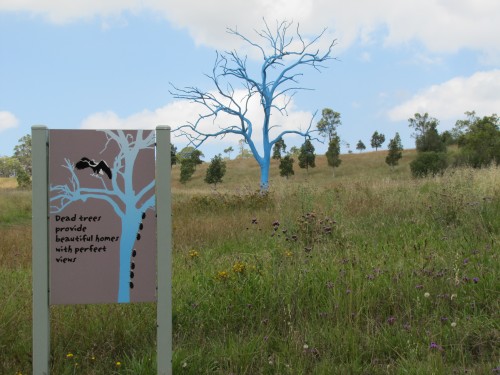It looks like a blue gum
I just had to stop and take a photo of this special tree in the Mt Annan Botanic Gardens in Sydney. Many of the trees in Australia are in the eucalyptus family, commonly known as “gum trees”. One group of them is also known as “blue gums”. The staff here in the gardens must have a good sense of humour.
The sign in the foreground explains the message they are trying to get across: “Dead trees provide beautiful homes with perfect views.”
Collectively, the gum trees of Australia provide homes for countless numbers of creatures. A single large tree – like the one in the photo – can be home to many species of insects, beetles, spiders, lizards as well as birds, bats, possums and many others. The trees provide shelter, roosting spots, nesting sites, nesting hollows, food and perching spots.
On the down side, millions of dead, mature trees like the one in the photo, have been chopped down for building materials, railway sleepers, firewood and for fence posts. Even a dead tree can provide a home for many creatures, especially if the tree has good nesting hollows. Owls and parrots especially like these hollows, and so do possums and bats. While large stands of mature trees do remain, the popularity of open fires and slow-combustion fires has accelerated the demise of many older dead trees.
Disclosure: I must confess to liking a wood fire myself, and so I am in a small way probably guilty of destroying some of these beautiful old trees. To partially lessen my guilt, only yesterday we arranged for a heating consultant to inspect our home to advise us on alternative methods of heating. Installing a reverse cycle air conditioner is the way to go, powered largely by our solar panels on the roof.
Reflection
While doing a spot of birding at the Barossa Reservoir last week I captured this rather interesting reflection of a tree. While there are no birds evident in the photo there were many all around, including Welcome Swallows swooping over the water, a large number of Eurasian Coot just to the left of the tree and a range of honeyeaters and other bush birds in the trees and surrounding scrubland. A Grey Fantail was heard nearby as well as Little Ravens calling in the distance.
Spotted Turtledoves nesting
The Spotted Turtledove is an introduced bird species in Australia. They are very common in many cities and towns in much of Australia. We usually have a few resident in our garden and near the house. On many occasions they have made nests and raised little ones.
Two weeks ago we had a near disaster in our garden. We had a very large 15 metre gum tree come down in our driveway in a violent storm. You can see pictures of some of it on my writing site here.
A few days after the storm I noticed a Spotted Turtledove gathering small sticks on the ground just outside my office. It was carrying the sticks into the thickest part of the canopy of the fallen tree. Little did it know that I was about to cut up that part of the tree the next day. Our movement nearby and the noise of the chain saw just metres away obviously frightened it away.
Two days later my wife saw the bird carrying sticks to another tree nearby. This time it had chosen a tree which was not on my demolition plans. The next day it had changed its mind and was building a nest in a thick bush on the other side of the house, a site they had used successfully in previous breeding attempts. I will keep an eye on it.
Rainbow Lorikeets feeding
We recently spent a few days in Victor Harbor on the south coast of South Australia. We stayed in the caravan park close to the beach. The park boasts many fine mature trees, including some eucalyptus trees which were heavy in flower. The local Rainbow Lorikeets were flocking in large numbers to feed on the nectar in the flowers, making a constant racket as they fed. During the day this was not much of a problem, though it did get on the nerves a little as it went on hour after hour.
The main problem came at first light, just when one is trying to get that last few minutes of sleep. A Rainbow Lorikeet screeching to his friends a few metres above your caravan is an unsettling alarm clock.
Related Articles:





